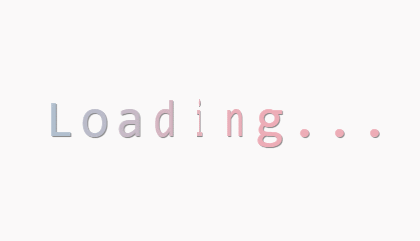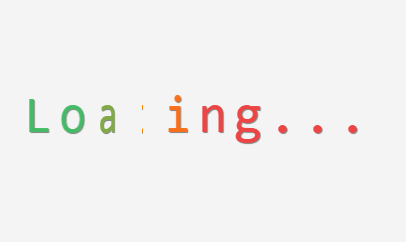
Dans l'article précédent "Utilisez CSS3 pour créer une image d'arrière-plan triangulaire sympa", nous avons présenté comment utiliser CSS3 pour créer un arrière-plan triangulaire sympa. Cette fois, nous continuons à partager les effets CSS3 et à voir comment obtenir des effets d'animation de chargement en utilisant du CSS3 pur. Ceux qui sont intéressés peuvent en apprendre davantage ~
Lors de l'accès à un site Web, comme de nombreuses images doivent être affichées, cela prend souvent un certain temps. charger. Si vous ajoutez ici un effet de chargement dynamique, cela ne rendra pas l'attente ennuyeuse. Par exemple, l'image ci-dessous ressemble à ceci :
Cet article partagera avec vous deux effets d'animation de chargement réalisés à l'aide de CSS3. Les deux méthodes sont implémentées à l'aide d'animation et de @keyframes. Jetons un coup d'œil au code d'implémentation :
Comment obtenir le premier effet :
<!DOCTYPE html>
<html>
<head>
<meta charset="utf-8">
<style type="text/css">
html,
body {
padding: 0;
height: 100%;
display: table;
margin: 0 auto;
font-size: 52px;
font-family: Monaco, Consolas, "Lucida Console", monospace;
background-image: url("http://subtlepatterns.subtlepatterns.netdna-cdn.com/patterns/kindajean.png");
}
.loading {
text-align: center;
display: table-cell;
vertical-align: middle;
text-shadow: grey 1px 1px 1px;
}
.letter {
float: left;
width: 35px;
height: 60px;
position: relative;
-webkit-animation: flip 2s infinite;
-webkit-transform-style: preserve-3d;
-webkit-transition: -webkit-transform 1s;
}
.letter div {
width: 100%;
height: 100%;
position: absolute;
-webkit-transform: translate(0);
-webkit-backface-visibility: hidden;
-webkit-animation: color 8s infinite;
}
.letter div.back {
-webkit-transform: rotateY(180deg);
}
.letter:nth-child(1),
.letter:nth-child(1) div {
-webkit-animation-delay: 0.125s;
}
.letter:nth-child(2),
.letter:nth-child(2) div {
-webkit-animation-delay: 0.25s;
}
.letter:nth-child(3),
.letter:nth-child(3) div {
-webkit-animation-delay: 0.375s;
}
.letter:nth-child(4),
.letter:nth-child(4) div {
-webkit-animation-delay: 0.5s;
}
.letter:nth-child(5),
.letter:nth-child(5) div {
-webkit-animation-delay: 0.625s;
}
.letter:nth-child(6),
.letter:nth-child(6) div {
-webkit-animation-delay: 0.75s;
}
.letter:nth-child(7),
.letter:nth-child(7) div {
-webkit-animation-delay: 0.875s;
}
.letter:nth-child(8),
.letter:nth-child(8) div {
-webkit-animation-delay: 1s;
}
.letter:nth-child(9),
.letter:nth-child(9) div {
-webkit-animation-delay: 1.125s;
}
.letter:nth-child(10),
.letter:nth-child(10) div {
-webkit-animation-delay: 1.25s;
}
@-webkit-keyframes flip {
0% {
-webkit-transform: rotateY(0deg) translate(0);
}
40%,
100% {
-webkit-transform: rotateY(180deg) translate(0);
}
}
@-webkit-keyframes color {
0% {
color: #88E488;
}
25% {
color: #EEADB7;
}
50% {
color: #90C9DB;
}
75% {
color: #F3B034;
}
100% {
color: #828282;
}
}
</style>
</head>
<body>
<div class="loading">
<div class="letter">
<div>L</div>
<div class="back">L</div>
</div>
<div class="letter">
<div>o</div>
<div class="back">o</div>
</div>
<div class="letter">
<div>a</div>
<div class="back">a</div>
</div>
<div class="letter">
<div>d</div>
<div class="back">d</div>
</div>
<div class="letter">
<div>i</div>
<div class="back">i</div>
</div>
<div class="letter">
<div>n</div>
<div class="back">n</div>
</div>
<div class="letter">
<div>g</div>
<div class="back">g</div>
</div>
<div class="letter dot">
<div>.</div>
<div class="back">.</div>
</div>
<div class="letter dot">
<div>.</div>
<div class="back">.</div>
</div>
<div class="letter dot">
<div>.</div>
<div class="back">.</div>
</div>
</div>
</body>
</html>Dans le code ci-dessus, utilisez d'abord deux animations. Les attributs lient deux animations. , flip et color, à chaque mot pour contrôler respectivement l'action de retournement et le changement de couleur ; puis utilisez les règles @keyframes pour définir les actions de chaque image des deux animations.
L'action de retournement doit être contrôlée à l'aide de l'attribut transform, qui peut appliquer une transformation 2D ou 3D à l'élément.
L'effet est le suivant :

L'effet suivant est également la même idée de mise en œuvre, juste légèrement modifiée dans les subtilités.
Comment obtenir le deuxième effet :
<!DOCTYPE html>
<html>
<head>
<meta charset="utf-8">
<style>
html,
body {
padding: 0;
height: 100%;
display: table;
margin: 0 auto;
font-size: 52px;
font-family: Monaco, Consolas, "Lucida Console", monospace;
background: #F5F5F5;
}
.loading {
top: 50%;
left: 50%;
width: 350px;
height: 60px;
font-size: 52px;
position: absolute;
text-align: center;
margin-top: -30px;
margin-left: -175px;
text-shadow: #808080 1px 1px 1px;
font-family: Monaco, Consolas, "Lucida Console", monospace;
}
.letter {
float: left;
width: 35px;
height: 60px;
position: relative;
animation: flip 2s infinite;
transform-style: preserve-3d;
transition: transform 1s;
}
.letter div {
color: #4B6;
width: 100%;
height: 100%;
position: absolute;
transform: translate(0);
backface-visibility: hidden;
animation: color 16s infinite;
}
.letter div.back {
transform: rotateY(180deg);
}
.letter:nth-child(1),
.letter:nth-child(1) div {
animation-delay: 0.125s;
}
.letter:nth-child(2),
.letter:nth-child(2) div {
animation-delay: 0.25s;
}
.letter:nth-child(3),
.letter:nth-child(3) div {
animation-delay: 0.375s;
}
.letter:nth-child(4),
.letter:nth-child(4) div {
animation-delay: 0.5s;
}
.letter:nth-child(5),
.letter:nth-child(5) div {
animation-delay: 0.625s;
}
.letter:nth-child(6),
.letter:nth-child(6) div {
animation-delay: 0.75s;
}
.letter:nth-child(7),
.letter:nth-child(7) div {
animation-delay: 0.875s;
}
.letter:nth-child(8),
.letter:nth-child(8) div {
animation-delay: 1s;
}
.letter:nth-child(9),
.letter:nth-child(9) div {
animation-delay: 1.125s;
}
.letter:nth-child(10),
.letter:nth-child(10) div {
animation-delay: 1.25s;
}
@keyframes flip {
0% {
transform: rotateY(0deg) translate(0);
}
40%,
100% {
transform: rotateY(180deg) translate(0);
}
}
@keyframes color {
1.5% {
color: #6AD;
}
3%,
12.5% {
color: #F80;
}
14% {
color: #4B6;
}
15.5%,
25% {
color: #F68;
}
26.5% {
color: #C83;
}
28%,
37.5% {
color: #96C;
}
39% {
color: #C83;
}
40.5%,
50% {
color: #E44;
}
51.5% {
color: #F80;
}
53%,
62.5% {
color: #4B6;
}
64% {
color: #F68;
}
65.5%,
75% {
color: #C83;
}
76.5% {
color: #96C;
}
78%,
87.5% {
color: #6AD;
}
89% {
color: #F80;
}
90.5%,
100%,
0% {
color: #4B6;
}
}
</style>
</head>
<body>
<div class="loader">
<div class="loading">
<div class="letter">
<div>L</div>
<div class="back">L</div>
</div>
<div class="letter">
<div>o</div>
<div class="back">o</div>
</div>
<div class="letter">
<div>a</div>
<div class="back">a</div>
</div>
<div class="letter">
<div>d</div>
<div class="back">d</div>
</div>
<div class="letter">
<div>i</div>
<div class="back">i</div>
</div>
<div class="letter">
<div>n</div>
<div class="back">n</div>
</div>
<div class="letter">
<div>g</div>
<div class="back">g</div>
</div>
<div class="letter">
<div>.</div>
<div class="back">.</div>
</div>
<div class="letter">
<div>.</div>
<div class="back">.</div>
</div>
<div class="letter">
<div>.</div>
<div class="back">.</div>
</div>
</div>
</div>
</body>
</html>L'effet est le suivant :

Ce qui suit présente les trois attributs clés animation, @keyframes et transformation :
CSS3 animation</ code> ( Animation) Propriétés <code>animation(动画) 属性
语法:animation: name duration timing-function delay iteration-count direction fill-mode play-state;
animation-name:指定要绑定到选择器的关键帧的名称 animation-duration:动画指定需要多少秒或毫秒完成 animation-timing-function:设置动画将如何完成一个周期 animation-delay:设置动画在启动前的延迟间隔。 animation-iteration-count:定义动画的播放次数。 animation-direction:指定是否应该轮流反向播放动画。 animation-fill-mode:规定当动画不播放时(当动画完成时,或当动画有一个延迟未开始播放时),要应用到元素的样式。 animation-play-state:指定动画是否正在运行或已暂停。
@keyframes 规则
使用@keyframes规则可以创建动画。创建动画是通过逐步改变从一个CSS样式设定到另一个。简单来说:@keyframes就是用来设置动画每一帧动作的。
@keyframes需要和animation 属性一起使用才能实现动画:
@keyframe规则由关键字“@keyframe”组成,后面接着是给出动画名称的标识符(将使用animation-name引用),随后是通过一组样式规则(用大括号分隔)。然后,通过使用标识符作为animation-name属性的值,将动画应用于元素。例如:
/* 定义动画*/
@keyframes 动画名称{
/* 样式规则*/
}
/* 将它应用于元素 */
.element {
animation-name: 动画名称(在@keyframes中已经声明好的);
/* 或使用动画简写属性*/
animation: 动画名称 1s ...
}CSS3 transform 属性
transform 属性向元素应用 2D 或 3D 转换。该属性允许我们对元素进行旋转、缩放、移动或倾斜。
语法:transform: none|transform-functions;
 tutoriel CSS3
tutoriel CSS3
 Quelles sont les propriétés du dégradé CSS3 ?
Quelles sont les propriétés du dégradé CSS3 ?
 ajouter l'utilisation
ajouter l'utilisation
 Le numéro virtuel reçoit le code de vérification
Le numéro virtuel reçoit le code de vérification
 Utilisation du mot-clé Type dans Go
Utilisation du mot-clé Type dans Go
 Quelles sont les technologies de sécurité des réseaux ?
Quelles sont les technologies de sécurité des réseaux ?
 Découvrez les dix principales crypto-monnaies dans lesquelles il vaut la peine d'investir
Découvrez les dix principales crypto-monnaies dans lesquelles il vaut la peine d'investir
 Utilisations courantes de l'ensemble
Utilisations courantes de l'ensemble